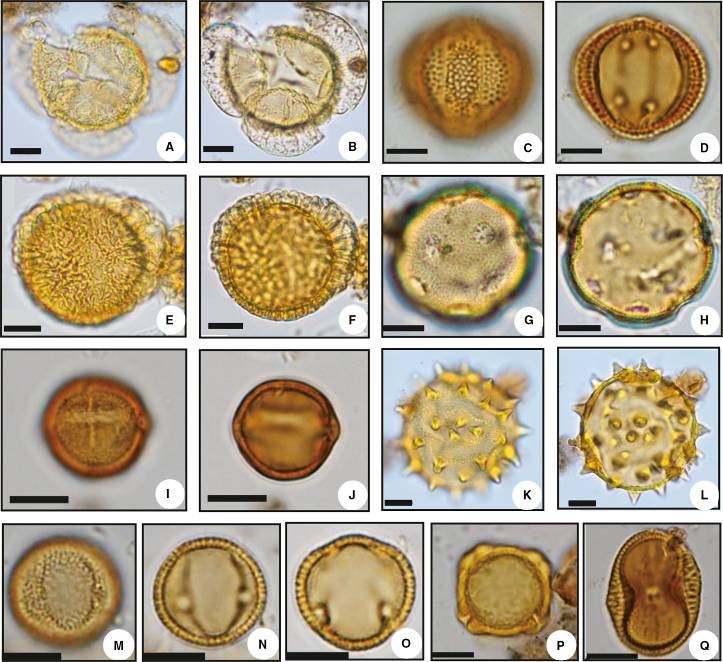
Pollen fossils extracted from Huguangyan Maar Lake sediment
The Earth’s climate changed from cold to warm through a succession of abrupt climate fluctuations over the past 30 000 years, including three important periods, i.e. the Last Glaciation, the Last Deglaciation and the Holocene, which casted great influence on the formation of human civilization and the development of early agriculture. Huguangyan Maar Lake in Zhanjiang, Guangdong Province is rarely affected by the outside disturbance because its supply is limited to a volcano formed ring dyke. The long time of water retention, simple lake system, and deep underground dyke make the Maar Lake sediments one of the valuable sites in the past global change study, which is comparable with deep sea sediments, polar ice cores and loess deposits. Huguangyan is located in the Leizhou Peninsula at the southernmost tip of Chinese Mainland, and adjacent to the South China Sea. It is under the inference of East Asian summer monsoon and southwest India monsoon, becoming a most important link between the South China Sea, the water vapor sources for the summer monsoon rainfall and the inland area. It is also a connection of the low latitude tropical climate system and the mid latitude monsoon climate.
In recent years, a research team combined by Prof. WANG Weiming and his postgraduate students MENG Yuting et al. from Nanjing Institute of Geology and palaeontology, Chinese Academy of Sciences, and Prof. HU Jianfang from Guangzhou Institute of Geochemistry, Chinese Academy of Sciences, carried out a systematic study of a drilling core from Huguangyan Maar Lake in Guangdong Province, South China. They reconstructed vegetation and climate changes over the last 30 000 years based on a relatively high-resolution pollen record. Pollen assemblages are well comparable with the results from ice-core, loess, stalagmites, lake and deep sea sediment records, reflecting that the tropical land system is very sensitive to both climate change on the solar orbit scale, and rapid climate events on the non solar orbit scales. This results provide a new scientific evidence for a better understanding of the interaction among the sea, the land and the plateau snow cover, the evolution of the monsoon, and the regional response of the global climate change in the low latitude region.
The pollen assemblages show a succession of vegetation and climate changes from 30 cal. ka BP. During the Last Glaciations, 30-15.8 cal. ka BP, the Huguangyan area was dominated by subtropical evergreen-deciduous forest with grassland surrounding the lake, reflecting a colder and drier climate than today. During the Last Deglaciation, 15.8–11 cal. ka BP, the content of evergreen and deciduous broad-leaved plants displayed a mutual growth and decline, indicating the study area was experiencing several climatic fluctuations. In the Holocene from 11 cal. ka BP, the tropical rain forest was common with the climate shifted to warmer and wetter conditions.

A comparison of the pollen assemblage with summer mean insolation, NGRIP ice-core, EPICA Dome C ice-core and Guliya ice-core records
During the Last glacial maximum (LGM), pollen assemblage showed no distinct millennial climate change recorded in some East Asia and high latitude regions. A clear warming event in about 21-18.5 cal. ka BP, might indicate a gradually warming climate in the Huguangyan area which was earlier than the high latitude area, but similar to the warming pattern revealed by the oxygen isotope records from the Antarctic and the Guliya Ice cores. In addition, the climate warming was synchronous with the increasing amount of sunshine at 33 ° north latitude, reflecting a highly responsible terrestrial vegetation system in the tropical area to the solar orbital scale changes.
Frequent climate fluctuations were recognized in the pollen assemblages during the Last Deglaciation, with a changing process from warm, to colder, warmer and cold climate. The evergreen broad-leaved forest expanded during 15.8-14 cal. ka BP, corresponding to Bølling-early Allerød warm period, while the subtropical deciduous broadleaved trees and grassland became re-established during 14-11 cal. ka BP, implying a cold period, possibly including the Younger Dryas.
The tropical rain forest got rapidly expanded during 11-6 cal. ka BP, which was consistent with that the arrival of Holocene climatic optimum with warm and humid climate condition. Tropical rain forest had a rapid decline in 8.5 cal. ka BP, implying a strong cooling event. The ratio of woody and herbaceous plants decreased in the middle and late Holocene, indicating a possible climate decay, which may be related to a weakening summer monsoon. The sediment record of the last 2 cal. ka BP cannot be used to interpret natural palaeoclimate changes due to the intense anthropogenic influences.
The article was published online on February 15, 2017 in Boreas. This research was funded by the CAS Strategic Priority Research Program and National Natural Science Foundation of China.
Article information: Yuting Meng, Weiming Wang*, Jianfang Hu, Jixiao Zhang, Yangjun Lai, 2017. Vegetation and climate changes over the last 30 000 years on the Leizhou Peninsula, southern China, inferred from the pollen record of Huguangyan Maar Lake.Boreas, doi/10.1111/bor.12229.
